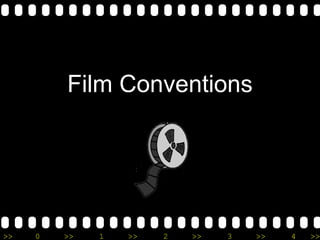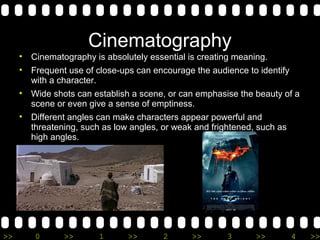Film conventions
- 1. Film Conventions >> 0 >> 1 >> 2 >> 3 >> 4 >>
- 2. Settings • Settings are used for a number of purposes. • They might be used to create verisimilitude, atmosphere, or be of symbolic importance to the narrative. For example, a storm could represent the inner turmoil a character is experiencing. >> 0 >> 1 >> 2 >> 3 >> 4 >>
- 3. Characterisation A narrative might use: • Sympathetic characters - with whom the audience strongly identifies with. They may share qualities and values. • Unsympathetic characters - audience dislikes them and may increase sympathy to main character. • Stereotypes – can reinforce existing ways of thinking about certain groups – appeal to the prejudices of the audience. >> 0 >> 1 >> 2 >> 3 >> 4 >>
- 4. Plot A narrative might use: • A liner narrative – events occur in chronological order. • Manipulation of time – flashbacks, as in the films of Sergio Leone eg. “Duck, You Sucker” • Suspense – it is hinted something dramatic is going to happen. • A climax and resolution (equilibrium restored) – main problem occurs, comes to a head and is sorted out. • A sting in the tail – ending is a complete surprise and unexpected. • An open ending – loose ends – audience left wondering as the story seems not complete. >> 0 >> 1 >> 2 >> 3 >> 4 >>
- 5. Casting • The appearance of actors can have a big effect on how a character is perceived by the audience. Also, previous roles an actor has had can influence our reaction. Bryan Cranston as Walter White (meth cook) •Why? He does not look like the average drug – interesting because he's way out of place. •What? He represents the “average” family man who will do anything for his family. •In his previous role as 'Hal' in 'Malcolm in the Middle', he played a caring father who was dependent on others. As Walter White, he rejects handouts and 'earns' his own money as a meth cock. >> 0 >> 1 >> 2 >> 3 >> 4 >>
- 6. Performance This also affects the way an audience responds. Elements of performance include facial expressions, body language, and delivery of dialogue. Javier Bardem as 'Anton Chigurh' •Blank facial expression •Occasional intimidating 'evil' laugh •Tall, big build. •Soft voice showing no empathy. •Kills without thinking – abrupt. >> 0 >> 1 >> 2 >> 3 >> 4 >>
- 7. Costume Costume affects our interpretation of characters. For example, a character's costume may conform to a stereotype – assuring our perception of them. It may make them look out of place – Walter White in Breaking Bad. Costume is of paramount importance to portray the time period the film is set in. Westerns typically feature duster coats, cowboy hats, revolvers, spurs etc. Futuristic films tend to have neon coloured tight all in one suits, lasers etc. >> 0 >> 1 >> 2 >> 3 >> 4 >>
- 8. Cinematography • Cinematography is absolutely essential is creating meaning. • Frequent use of close-ups can encourage the audience to identify with a character. • Wide shots can establish a scene, or can emphasise the beauty of a scene or even give a sense of emptiness. • Different angles can make characters appear powerful and threatening, such as low angles, or weak and frightened, such as high angles. >> 0 >> 1 >> 2 >> 3 >> 4 >>
- 9. Lighting • Soft and harsh lighting can manipulate a viewer's attitude towards a setting or character. • As an example, the house on the light is perceived as quiet and friendly and it could easily be placed in a family comedy. However, the lighting has been changed on the right and it turns into a dark and gloomy house that could easily be placed into a drama thriller/horror. >> 0 >> 1 >> 2 >> 3 >> 4 >>
- 10. Sound • Sound builds up the atmosphere. • A scary horror scene – creepy low pitched music in background, creaking door, footsteps becoming increasingly loud as someone gets closer etc. • Sad scene – slow and emotionally powerful music. • Happy scene – laughter, joy, upbeat music. • Serious scene – may use silence to enhance the atmosphere. • Types of sound include; Editing -ambient -synchronous/asynchronous -sound effects -diegetic/non-diegetic • Certain uses of editing can be used to convey excitement and chaos, or slow editing with long takes can be used to create suspense or emotion. >> 0 >> 1 >> 2 >> 3 >> 4 >>









